Ultimate Customer Feedback Survey (with Examples!)


A customer feedback survey template can be your ultimate tool to measure customer satisfaction.
One of the best ways to know what your customers think, want and feel is to ask them.
Let's start creating customer satisfaction surveys.
But how can you make sure that you ask the right questions if every client is different? How can you measure the satisfaction of your clients without any prior experience in this field?
Our guide will help you quickly set up an effective customer journey map and design engaging customer satisfaction surveys.
By the end, you'll be able to:
- Define your customer journey
- Find the touch points that are most likely to affect customer loaylty
- Use the right questions according to your specific needs
- Ask all clients 7 impactful questions
- Customize and use customer satisfaction survey templates for Net Promoter Score (NPS), CSAT, and CES
Excited to try out how you can transform your survey feedback into social proof for your business?
Skip the Research – Send Customer Satisfaction Survey
There's so much to think about when it comes to creating customer satisfaction surveys.
Let's do that together, and send a survey to your existing customers.
In 30 minutes.
For free.
Results from Trial
We helped Saintex create and send NPS surveys to B2B customers. The results were staggering.
- Almost 300 responses
- High response rate
- NPS over 80 (on a scale of -100 to 100)
- NPS average 9.35/10
- 80 reviews from business decision makers
- Lots of praise for products, services, people
Define Your Customer Journey (and Goals!)
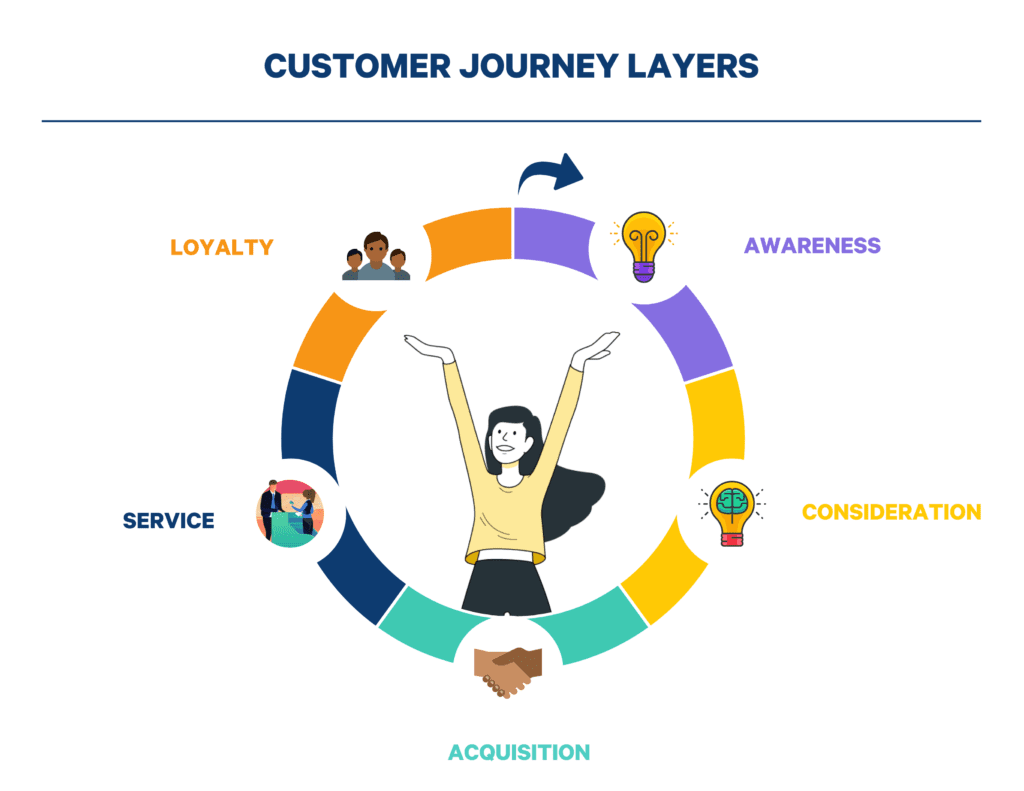
A customer or clients’ journey is an end-to-end view of the clients' interaction with your company. It shows touchpoints, interactions, and events throughout the customer lifecycle.
There are various forms of this journey. However, let's keep it simple and focus on the five following sections:
- Awareness
- Research
- Selection
- Delivery
- Follow-Up
Awareness
The client becomes aware that they have a need or problem your product or service can solve.
Websites, billboards, TV ads, and social media posts are all ways to draw attention to your product.
Receiving survey feedback on the level at which clients notice these forms of advertising is essential for future campaigns and promotions.
Research
Customers will now look for solutions to their problems.
The client may look for product reviews, customer testimonials, speak to friends, family, and colleagues, or search Google.
This step is crucial as it can set the journey in progress; clients who find lots of negative information on your brand may drop off at this point. It's highly important to answer to answer to all negative reviews!
It shows you care about your customers and are willing to work on getting better.
Selection
After researching different brands, clients narrow down their options and create a shortlist. Build your brand to beat the competition!
It is essential to understand why they select your product over others, including price, quality, or even word of mouth.
Asking for feedback on anything in the selection phase will help you improve in this area.
Delivery
After choosing your product, clients receive their purchase. If the product does not fulfill their expectations, it can affect future business from this client.
There are various ways to gather customer feedback at this stage; asking for a one-off review or offering an incentive to complete a customer satisfaction survey after a week or month of delivery.
Follow Up
A final opportunity to gather feedback is after the client has had a chance to use your product.
That can be a simple question on a receipt, a customer satisfaction survey after a sale, or an offer for additional support if needed.
This part of the journey can be as important as the initial research stage. Clients always appreciate brands that care about their experience with them and are happy to fulfill surveys that help them engage with the company.
Now you have a basic understanding of the different phases of the client journey. You can get more of an in-depth look at the client journey by reading one of our previous posts here.
Let's move forward and define the client journey specifically for your brand.
How to Define Customer Journey?
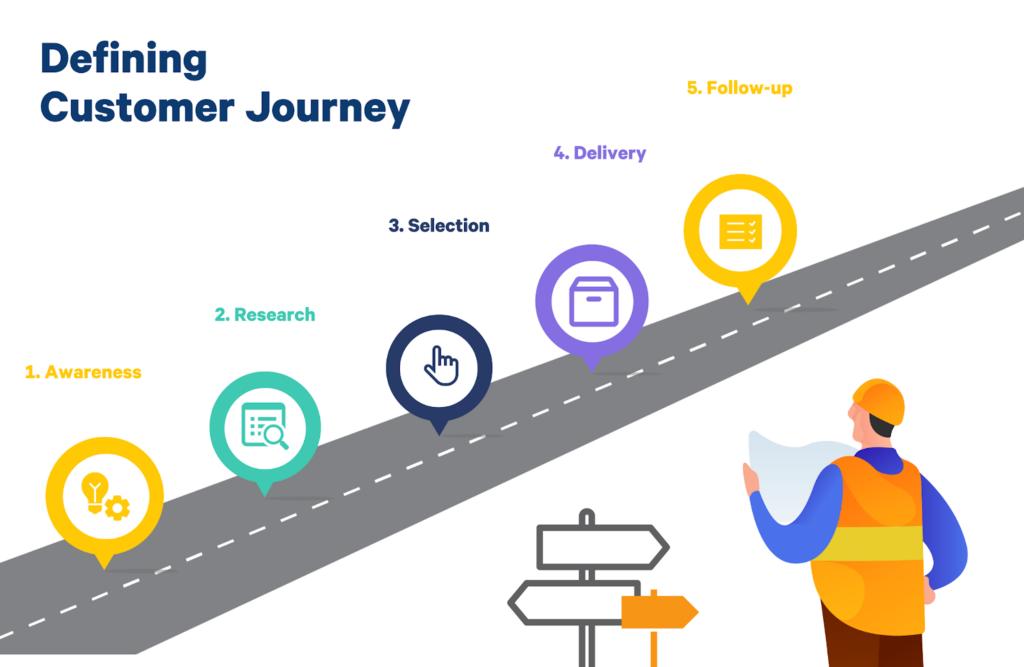
Tailoring the journey to your specific company is vital for effective feedback.
By doing so, you allow for personalization across various aspects of the client's journey. That personalization leads to a better relationship between you and your clientele.
To create a unique client journey for your company, you should put yourself in the clients' shoes.
The following table will help you give the right start when beginning to map your customers' journey.
| Awareness | Research | Selection | Delivery | Follow-Up | |
| Behaviors | |||||
| Thoughts | |||||
| Touchpoints | |||||
| Weaknesses | |||||
| Opportunities |
The above represent action steps you should consider when mapping out your client journey. It considers the various stages that your brand offers while also considering the clients' points of view.
Pro Tip: Customer satisfaction survey best practices include considering the stage of the customer journey the customer is currently in.
At every stage, the client has:
- Behavior and actions
- Thoughts and feelings
- Touchpoints
- Weaknesses
- Opportunities
Behavior and Actions
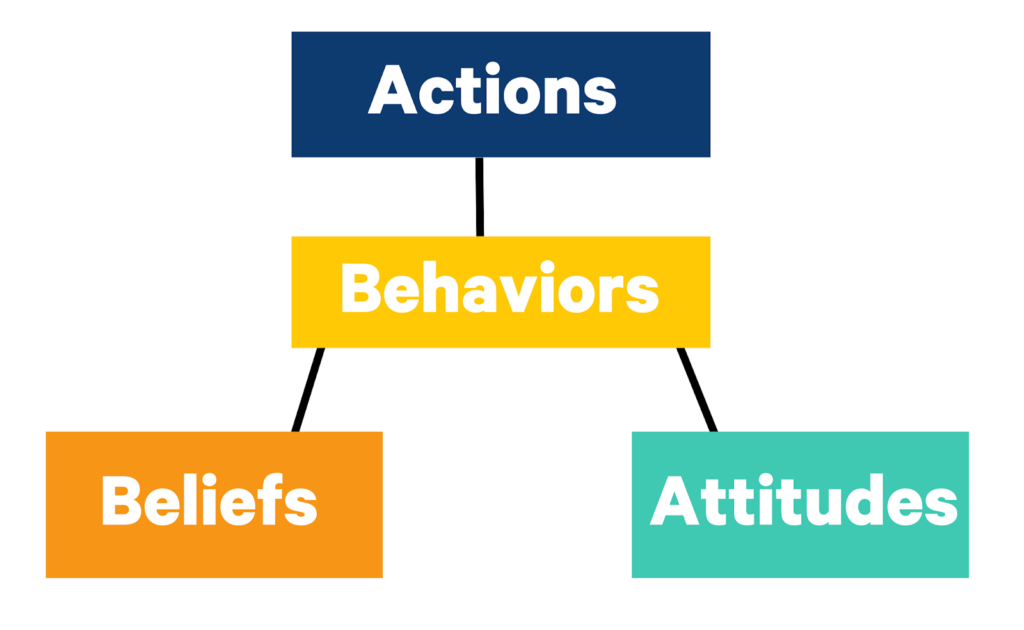
What is the client doing during each of the stages? Are they returning your product? Are they looking for a refund?
By focusing on clients’ actions in each stage of their journey, you can identify patterns for improvement.
Thoughts and Feelings
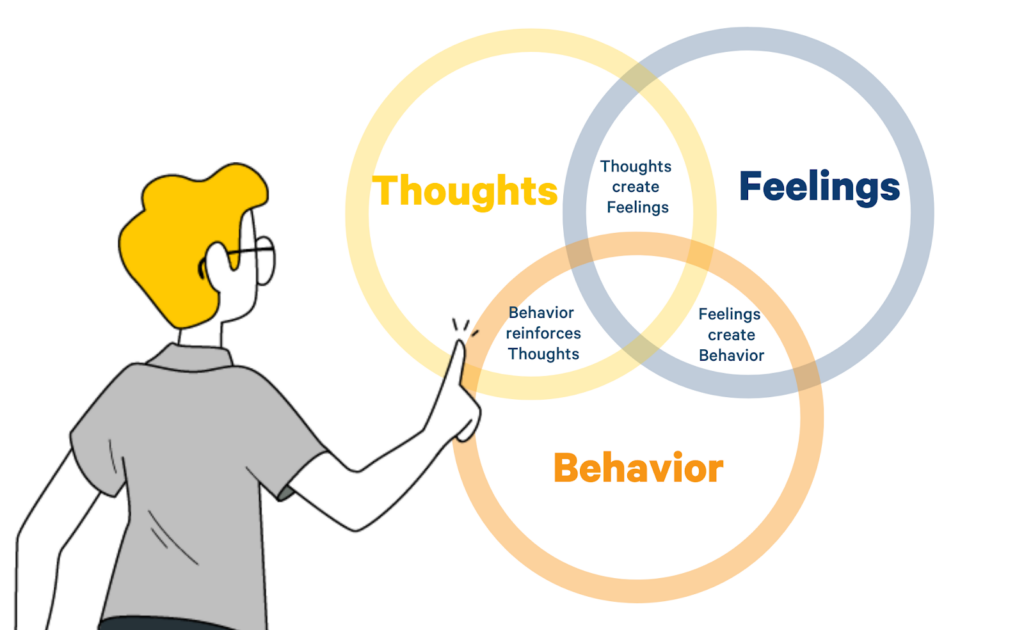
What thoughts are going through the clients' minds during different stages? Are they satisfied? Nervous? Angry?
What are they looking for? Do they have any questions that need to be answered?
Touchpoints
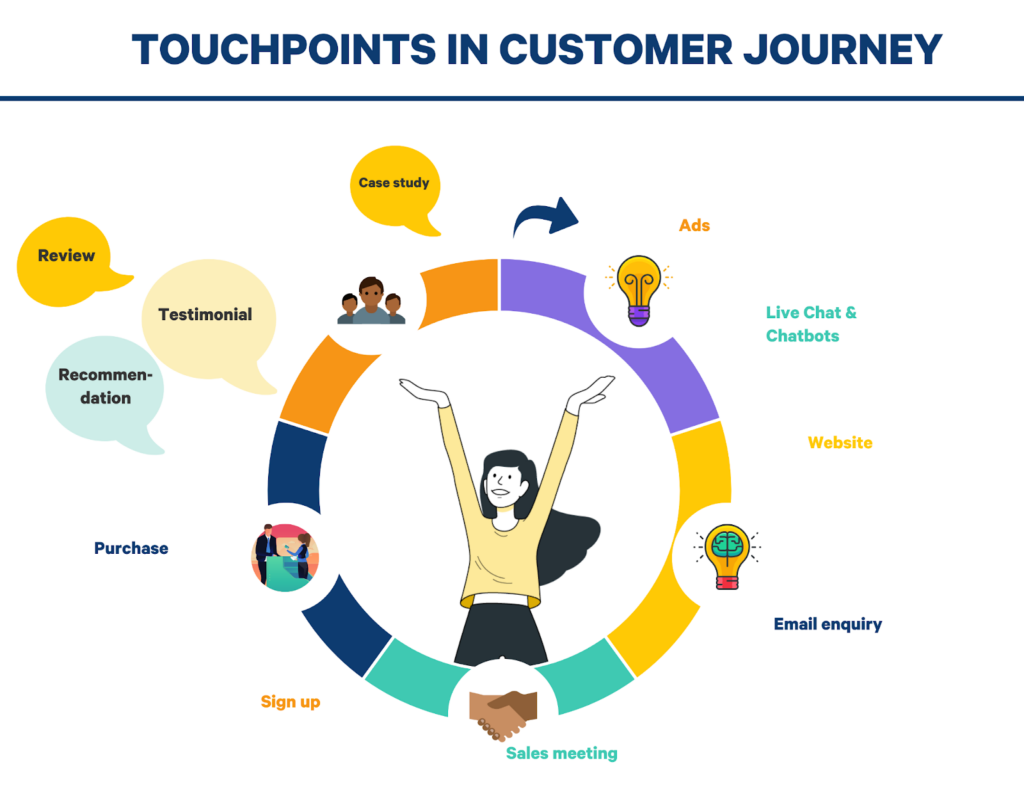
Think of touchpoints as the links and connections of the client’s journey; that is why they are crucial.
Touchpoints refer to the time of interaction between your business and your clientele.
Connecting with clients through touchpoints is integral to creating a successful campaign.
When filling out the template, try and focus on the various touchpoints you offer to clients throughout the different stages.
Weaknesses
Weaknesses highlight the common pain points your clientele is facing. These could include poor after-sale support or problems on the website.
The goal in outlining these pains is to work on them during the different stages of the clients’ journey.
Opportunities
The last row, opportunities, summarizes questions and problems clients have. Furthermore, this part highlights the areas where you need to focus your efforts as a company.
After defining the ‘journey’, you are ideally placed to collect feedback through customer satisfaction surveys effectively. The following section will cover the various questions you can use in your survey.
Customer Satisfaction Survey Questions (9 types)
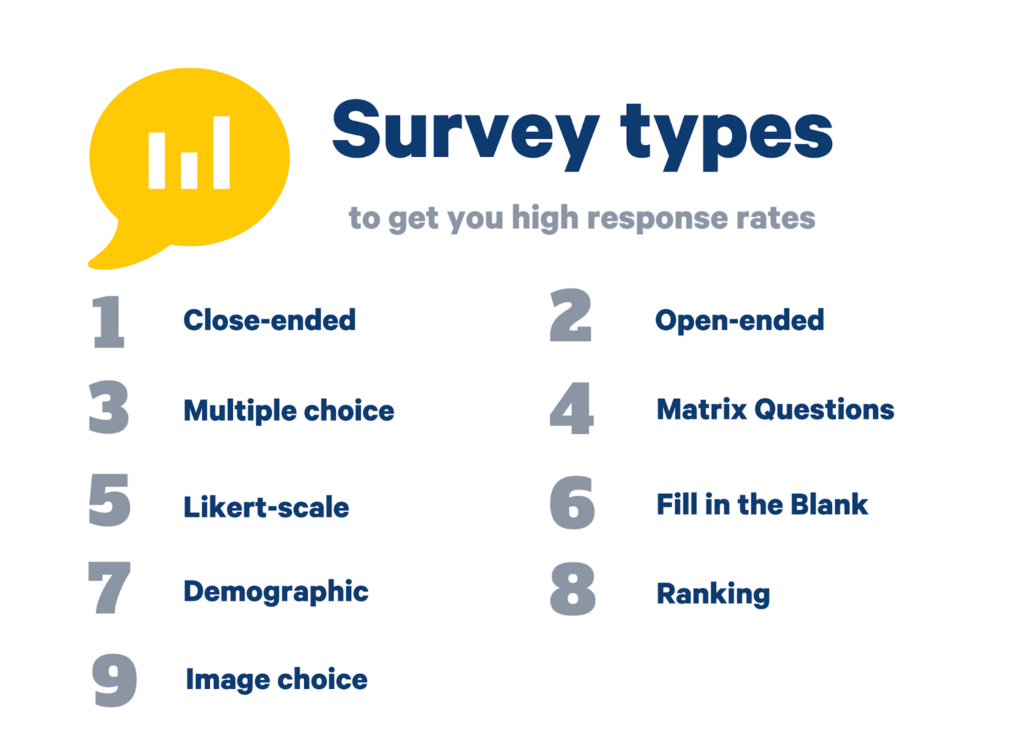
A customer satisfaction survey can take different forms. There are several ways to collect feedback, from asking clients for a verbal review to emailing a survey to fill out an in-depth questionnaire.
The customer satisfaction survey questions you ask can significantly impact your feedback. A poorly formatted questionnaire will receive fewer responses with less relevant information.
On the contrary, you will get more respondents and better insights by asking relevant and straightforward customer feedback questions. Thus, you can increase survey engagement.
To make sure your customer satisfaction survey gets the right start, consider the following question types:
- Close Ended Questions
- Open-Ended Questions
- Multiple-Choice Questions
- Matrix Questions
- Likert Scale Questions
- Fill in the Blank
- Ranking Questions
- Demographic Questions
- Image-Choice Questions
Let's see how these can be best used to make effective customer satisfaction survey templates.
1. Close-Ended Questions
Close-ended questions are the traditional form of a customer satisfaction questionnaire. They simply require a yes or no answer to a question, with no follow-up comments.
To make these effective, think about the questions you want answered. They could be specific to a certain product or service, or you could use general questions that apply to the company as a whole.
Example
If you want to know whether clients found your product easy to use, add this question in your survey:
"Did the product meet the requirements on the website?”

2. Open-Ended Questions
These are the opposite of close-ended questions, in that people are asked to provide feedback on specific points in their own words.
This type of question allows people to express the specific problems they may be having and their thoughts and feelings on your product.
Example
If you want to know what your customers think about your brand's customer service experience, your survey should include:
"How do you feel about our customer service and our customer support team?"

3. Multiple-Choice Questions
These are some of the quickest and easiest survey questions, as customers only have to select one answer. While they are simple, there is the risk that customers will feel under pressure to complete them quickly and may not give serious thought to individual choices.
To make these effective, try limiting the number of options to provide better insights. Having only two options also gives you a chance to ask follow-up questions, such as "why?"
Example
You want to know what customers think of your website, ask the following question in your survey that you can embed on your website:
"What do you think about our website? Is it easy to navigate?"
The answer could include four options:
- "Easy to use, would recommend to friends and family."
- "Easy to use, but possibly too simple for my needs."
- "Difficult to use, would not recommend."
- "Fully intend on using it, but it looks complicated."
4. Matrix Questions

Matrix questions allow you to group various questions in the survey. Furthermore, the answers to all the questions are combined into one response.
That allows you to get specific answers to each question while also understanding how customers feel about your product overall.
This type of question puts a broader range of issues before the customer, who can feel overwhelmed if there is too much to read. However, you can also add a neutral option for customers who may not have an opinion on a topic.
Example
If you want customers' thoughts on your business as a whole, you can ask a group of similar questions in your customer survey:
- "How would you rate our overall service?"
- "Is our product/service unique?"
- "Would you recommend us to your friends or colleagues?"
- "Can we improve anything in our service or product?"
You can give customers a rating scale to answer all the questions and combine them into one response.
5. Likert Scale Questions

Likert scale questions are good for asking customers' favorability towards a particular topic. They have several options, ranging from 'strongly disagree' to 'strongly agree.'
It is best to use odd number options to allow neutral customers to also engage with the questions.
Example
By referring to the previous case, if you wanted customers' thoughts on your business as a whole, your customer survey should have the following question:
"Does our service cater to all your needs?"
The answer should offer an odd number scale with the following options:
- "Strongly disagree."
- "Disagree."
- "Neither agree nor disagree."
- "Agree."
- "Strongly agree."
If customers aren't satisfied with the services you provide, it's a good idea to ask why. Then, you can ask if there's anything that could be done to improve the service.
As you can see, Likert scale questions offer an excellent place to start when you want to elicit specific responses but don't want to go into too much detail.
6. Fill in the Blanks
Fill in the blank statements help encourage customers to detail their opinions and experiences. They also allow you to capture specific points that you may not have previously considered.
You can give an incomplete statement and ask customers to finish it.
Example
"One of the most difficult parts of our service is _____ ?"
You want to avoid any controversial statements to ensure customers feel comfortable sharing their thoughts.
Another way you can use fill-in-the-blanks is by asking a question and leaving a few spaces for customers to fill in the answers.
- “Our product is world-class because _____ ?”
- "We are always looking for ways to improve our service. If you could give us feedback, it would be ____ ?"
7. Ranking Questions

Ranking questions are all about giving your customers a choice of topics and asking them to rank them from most important to least.
Ranking questions also allow you to group several issues without overwhelming customers.
This question is ideal for understanding customer preferences for different areas of your product/service.
Example
"Which of these factors do you consider the most important when it comes to our product/service?"
The ranking list for the above example can include options like:
- "Quality over quantity"
- "High ethical standards"
- "Price competitiveness"
8. Demographic Questions


Demographic questions are handy when you want to use a survey to understand the demographics of your customer base.
They're also great for understanding general attitudes and behaviors in the wider population.
You can ask demographical questions to understand how your customer base differs from the general public and find out what type of customers exist and their commonalities.
Example
- "How old are you?"
- "What is your gender?"
- "Which area do you operate in?"
These questions are a good way of finding out what different types of customers you have and what kind of customer doesn't exist yet.
9. Image-Choice Questions

One of the best ways to support your feedback is to use images. Images allow you to evoke a greater emotional response from customers and create a more memorable experience for clients attempting the survey.
You can provide a list of images and ask customers which one they identify with the most. When using image-based or picture questions, it can be essential to use high-resolution images.
This section covered some of the significant survey question types you can use to form your customer satisfaction surveys. As a quick summary, here are the different survey questions we covered:
| Questions | Used For |
| Close-ended questions | Use them when you want a simple yes/no response or a set of pre-defined options to choose from |
| Open-ended questions | These are useful for asking customers to provide a detailed explanation of their opinion. Don't overuse them as they can be time-consuming and challenging to analyze. |
| Multiple-choice questions | They present customers with three or more options to choose from. You can also include "no opinion" as an option to capture those who didn't have a strong preference. |
| Matrix questions | Use these questions to investigate specific areas of your product/service. Give each area a score, and ask customers to rate how important it is to them. |
| Likert scale questions | Present customers with statements and ask them to rate the truthfulness of each statement on a scale. |
| Fill in the blanks | Give customers a sentence and ask them to complete it. They are perfect for getting immediate feedback about specific aspects of your service. |
| Ranking questions | Present customers with a list of topics to rank them. That enables you to know customer preferences about your product/service areas. |
| Demographic questions | Find out the age, gender, and location of your customer base. They are ideal for segmenting the customer base and making customer profiles. |
| Image-choice questions | Use these questions to increase customer engagement with your feedback. Provide a list of images and ask them to choose the one they identify with most. |
Look no further than one of our previous blog posts to learn how to create effective survey questions.
7 Questions to Ask from Customers
By now, you should have an idea about the proper survey question on your customer satisfaction surveys.
But what about the actual content?
The survey question/questions you ask should aim to solve a specific problem - you should always aim to understand your customers and their opinions as well as possible.
It can be difficult to think of what questions to ask, so we have compiled a list of our
7 go-to customer satisfaction survey questions
- How can my company better serve your needs?
- How satisfied are you with (brand name) products/services?
- What value do we provide?
- What are your biggest challenges?
- Why did you choose (brand name) over the competition?
- Would you recommend us to a friend?
- What else can we help you with?
These questions are designed to find out as much as possible about your customers' needs and provide them with the opportunity to provide additional feedback.
Let's consider each question and how it allows you to understand the customer
1. How Can My Company Better Serve Your Needs?
This survey question lets customers know they are being listened to. That makes the customer feel valued and increases their likelihood of responding positively to future requests.
Some ways to ask the above question are:
- "Do you have any specific feedback on how we can better meet your needs?"
- "Is there anything else that would help us to better serve your needs?"
2. How Satisfied Are You with (Brand Name) Products/Services?
This question is designed to establish if your customers are satisfied with the product or service you are delivering.
It is not a question about how happy they are with your company as a whole, so there is no risk of bias when answering.
Alternative Ways to Ask
- "Are you satisfied with our product/service?"
- "How would you rate the quality of our product/service?"
3. What Value Do We Provide?
This question allows you to identify how your customers view your business.
After the "How satisfied are you with our product/services" question, it is beneficial to ask about the value those services provide. By doing so, you will know whether the customer is satisfied with your product and if they see the value.
Alternative Ways to Ask
- "What are the main benefits you get from our services?"
- "What makes our products/services valuable to you?"
4. What Are Your Biggest Challenges?
This question revolves around asking customers their pain points.
It is vital to ask this question. It lets the customer know you are interested in solving their problems and helps you understand what they struggle with.
You might also find it helpful to ask, "Do you have any ideas on how we can tackle these problems?" That gives customers a chance to be creative and have their opinion heard.
Alternative Ways to Ask
- "What is your biggest challenge?"
- "What are the biggest challenges you face?"
5. Why Did You Choose (Brand Name) Over the Competition?
This customer support question aims to find out why customers choose you over another company.
By understanding why the customer chose you, you will have a better idea for marketing your company and the aspects you should focus on.
You can also find out what aspects your competitors are doing well in to help you better serve your customers.
Alternative Ways to Ask
- "Why didn't you choose our competitor?"
- "If you switch to a competitor, who would it be and why?"
6. Would You Recommend Us To A Friend?
If you want to know whether customers will recommend you to someone else, you should ask this customer support question.
It can be helpful to ask this question at the end of an online survey so you know the answer is genuine.
Alternative Ways to Ask
- "Would you recommend our services to a friend or colleague?"
- "Would you recommend our product/services to others?"
7. What Else Can We Help You With?
This customer support question helps keep your survey responses open-ended, meaning you will get the most out of your data.
It allows customers to provide feedback about anything they think you should know.
Alternative Ways to Ask
- "Do you have any other feedback that we could act on?"
- "Are there any other areas you think we should improve in?"
To sum it all up, using these questions will help you create a better customer satisfaction survey. These seven questions cover all the key areas of the survey and help you improve business and customers satisfaction levels.
Why not book a meeting to learn about the features of our software that can help you build great B2B feedback surveys?
3 Ready-to-use Customer Satisfaction Survey Templates
By now, you should know how to design a customer satisfaction survey and what questions you can ask.
This section contains three customer satisfaction surveys templates. You can and should use these customer satisfaction survey examples as the foundation to create your ultimate survey.
I have separated them according to three famous customer experience metrics: NPS, CES, and customer satisfaction score CSAT.
Net Promoter Score (NPS)
The Net Promoter Score (NPS) is one of the most popular customer satisfaction metrics. It helps you understand how willingly a customer would recommend your business to a friend or colleague.
If you'd like to know more, here is everything you need to know about NPS.
The NPS is calculated using this formula:
NPS = % of Promoters – % of Detractors
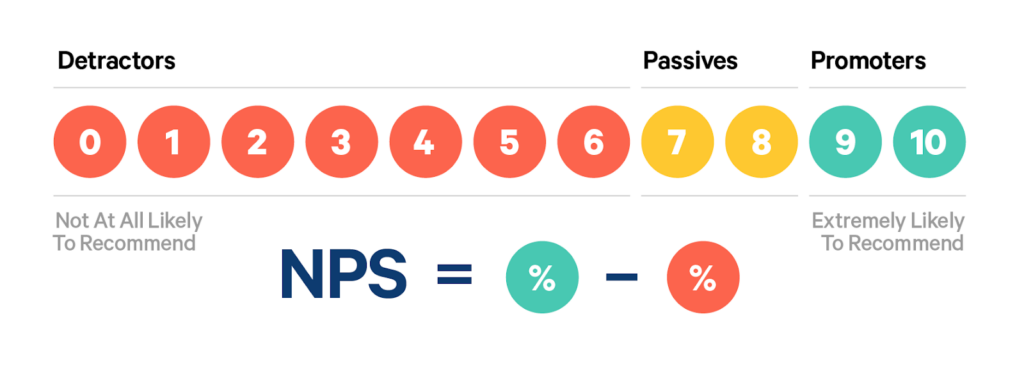
The following is the simplest and most efficient NPS template. (You can try it out by clicking on it!)
With Trustmary, you can add any imaginable additional question to the same survey.
- "What changes do we have to make for you to give us a higher rating?"
- Demographic questions, such as: for B2C"What is your approximate average household income?" and for B2B: "How many employees do you have?"
- "Would you like us to contact you about the feedback you gave us?"
Anything! Book a meeting and we'll tell you more.
Customer Satisfaction CSAT
Collecting customer satisfaction is all about understanding how satisfied your customers are with your company at a specific time. It provides a broad view of the consumer market.
Customer satisfaction is calculated using this formula:
% Satisfied customers = (Number of satisfied customers/ Number of survey respondents) x 100
The following is a customer satisfaction survey template that will help you collect customer satisfaction data.
Are you looking for software that can help you measure customer satisfaction? Our Petteri compared 10 CSAT software that'll help you gauge
Customer Effort Score CES
It doesn't get simpler than this for your customer to let you know how you're doing.
The customer effort score (CES) tells you how much effort the client requires when dealing with your company to solve a specific problem.
The customer effort score provides a distribution that you can use to differentiate your customers. You can see the average effort score of customers and pinpoint any outliers.
The main question in CES is, "How easy was it to solve your problem?"
An odd number scale allows customers to log in scores. Thus, the customer effort score is calculated using this formula:
CES = (Total sum of responses) / (Total number of responses)
The higher the score, the easier it is for customers to solve problems. Thus, you should always aim for a score above the median value of the scale.
Pro Tip: You can and should end all customer satisfaction surveys by thanking the customer for investing their time to give you feedback.
You can do this by adding this line at the end:
"Thank you for your valuable time and interest in our company. We appreciate it a lot!"
Let's summarize using a simple table:
| Metric | Used For | Main Question |
| NPS | Ideal when you want to understand how likely a customer would recommend your company. | How likely is it that you would recommend this product/service/company to a friend or college? |
| CSAT | Helps you know about customers' satisfaction at a specific point in their journey. | Are you satisfied with the interaction between you and the company? |
| CES | It is perfect when you understand how easy it is for a customer to accomplish their goal. | How easy was it to solve your problem today? |
Ready to make customer satisfaction surveys? Try out our survey-maker. You'll get the power of read-made templates, unique customizations, varied integrations, and extensive reporting at your fingertips.
Or create a customer review form. Whatever it is you need!
Focus on Your Customer Experience
Customer feedback surveys are powerful tools for brands that want to keep their finger on the pulse of their customer base.
The ultimate customer satisfaction survey will help your brand/company/service stand out from the competition.
We have done the following that can help you accomplish that:
- Understanding customer paths and creating a map per your business.
- Using unbiased customer satisfaction survey questions to measure satisfaction
- Finally, creating fantastic customer satisfaction survey examples using templates.
Whether you want to calculate NPS, CSAT, CES, or more, Trustmary can help.
Our custom survey builder can help you create tailored customer satisfaction surveys simply.
Furthermore, you can use the data and convert it into social proof for your business without hassle.
Further Reading
FAQ on Customer Feedback Surveys
Which is the best metric to measure between NPS, CSAT, and CES?
NPS is the best metric to measure between CSAT and CES. It looks at the entire customer experience. Furthermore, it can easily be benchmarked.
- CES captures whether your customer could simply solve their problem or not.
- CSAT captures whether your customer feels satisfied with their interaction.
- A high NPS score suggests that your customers are acting as brand ambassadors.
What channels should I use to send out a survey?
You should always aim to offer an omnichannel feedback option to customers. Some channels that you can consolidate together are:
It is best to use the channel where most of your audience spends time. Or through the channel you normally communicate through.
Here are some tips for sending NPS surveys via emails for maximum results.
What is a customer journey map?
A customer journey map shows the entire experience your customers have when they come in contact with your product or service.
It is used to understand customer experiences and expectations when using your products.
That way, you can create a customer satisfaction survey focused on the right things.
How long should the survey be?
Ideally, your survey shouldn't take more than 1 minute to complete.
To know how much time your customer will need, you should pilot-test each of your surveys. That way, you can learn how long your customers will take to answer.
Good rule of thumb is to keep it simple.
How important is the tone of voice in a survey?
The tone of voice you use in your survey is fundamental. It should be engaging and inviting enough to encourage customers to fill in your survey.
However, it should be serious enough that customers answer honestly.
What are the best customer satisfaction survey practices?
When designing a customer satisfaction survey, some best practices you should follow are:
- Do not ask biased questions. Remove all possible leading questions or "double-barreled" questions.
- Do not ask open-ended questions at the beginning of your survey. Begin with a closed-ended question.
- Ask closed-ended questions after you have gained customers' trust and they are beginning to enjoy your survey the most.
- Always include at leeast one open-ended question in your survey. That way, you allow customers to share any hidden gems you might have missed out on.